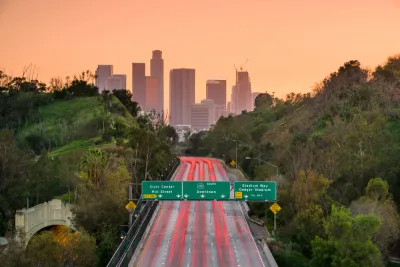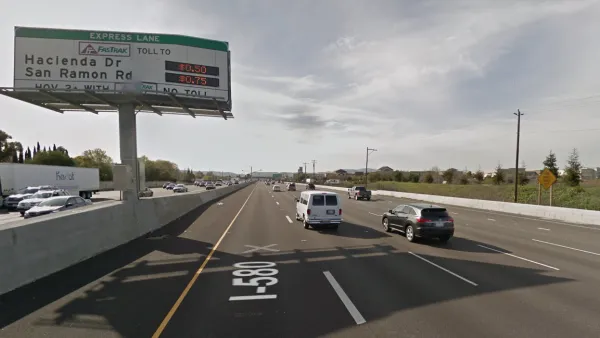California began the Road Charge Pilot Program on July 1 to see how participants would respond to being charged by the mile driven rather than by gallons of fuel consumed. Participants may now have received their first 'mock' invoices.

California faces a transportation funding shortfall. Gas taxes were reduced by 2.2 cents per gallon last month. In 2014, a new method of charging drivers for infrastructure was approved in the form of a pilot program.
Meghan McCarty, who covers commuting and mobility issues for the NPR Southern California affiliate, KPCC, enrolled in the California Road Charge Pilot Program that began July 1.
Depending on the method chosen, enrollees may receive a "monthly statement road charge" showing a "simulated payment" as no actual payments are exchanged. McCarty explains the process in a one-minute audio tape.
For starters, the state has to figure out how much I'm driving. The program offers six different ways to track the distance I drive, from simply recording odometer readings to high-tech devices that monitor a vehicle's mileage and location.
The pilot program's homepage lists four methods (shown with images at base of post):
- TIME PERMIT: A permit that allows unlimited road use in California for a specific period of time, such as a year, month or week.
- MILEAGE PERMIT: A block of miles based on your expected use of California’s roads.
- ODOMETER CHARGE: An option where payment is remitted after periodic manual odometer readings.
- AUTOMATED MILEAGE REPORTING: Choice of in-vehicle technology, with or without general location data, that reports mileage traveled to a third party account manager which invoices the participant.
The charge is 1.8 cents-per mile, though, as indicated above, it's a 'mock' fee as no payments are made.
To see what mock road charges I’d racked up, I opened a smartphone app that connects to the device. It tells me I’ve driven 463 miles in the past month. So I would have been charged $1.46 under the road charge system. That's about 38 cents more than I probably paid in gas taxes over the same period.
Actually, as reader Tcommented on August 5:
[Y]ou were actually being charged $1.46 for the 81.2 miles that were driven in August (81.2 miles x 1.8 cents/mile = $1.46).
Bills can difficult to interpret, but the simulated invoice that appears in the article is thorough, indicating fuel usage, fuel tax credit, resulting in a net charge of $.38.
Rewards fuel inefficiency
As I suspected, the program is run just like OReGO, which, like the California pilot, has a set mileage charge (1.5-cents per mile) that credits motorists for their fuel taxes paid. Gas guzzlers receive lower invoices or even rebates [see: April 29, 2015: A Serious Shortcoming in Oregon's Road Usage Charge].
McCarty explains:
The results aren't unexpected -- I've got a fairly new car with good gas mileage, so it makes sense that the road charge would be more. The opposite might be true for older cars that are less fuel efficient.
California and Oregon are the only states operating actual vehicle miles traveled fee (VMT fee) programs. The major difference between the programs is that California's is a pilot while Oregon's is the real thing; no mock payments.
Oregon completed two pilot programs. The current program, which commenced July 1, 2015, will continue until the legislature terminates, revises, or replaces it.
Bottom line for California program:
Once the state collects information from the nine-month pilot, officials will assess whether the method provides a more stable revenue stream to fund road repairs. The state legislature would then have to vote to institute the program on a permanent basis.
 TIME PERMIT
TIME PERMIT
A permit that allows unlimited road use in California for a specific period of time, such as a year, month or week. MILEAGE PERMIT
MILEAGE PERMIT
A block of miles based on your expected use of California’s roads. ODOMETER CHARGE
ODOMETER CHARGE
An option where payment is remitted after periodic manual odometer readings. AUTOMATED MILEAGE REPORTING
AUTOMATED MILEAGE REPORTING
Choice of in-vehicle technology, with or without general location data, that reports mileage traveled to a third party account manager which invoices the participant.
Related on Planetizen:
- June 24, 2016: California Road Charge Pilot Launches July 1; Gas Tax Increase Still Needed
- March 20, 2016: Technology Companies Selected for California Road Charge Pilot
- January 30, 2016: California's Road Usage Charge Pilot Program to Begin on July 1
- April 29, 2015: A Serious Shortcoming in Oregon's Road Usage Charge
FULL STORY: Which costs more for drivers — per-mile charge or gas tax?

Analysis: Cybertruck Fatality Rate Far Exceeds That of Ford Pinto
The Tesla Cybertruck was recalled seven times last year.

National Parks Layoffs Will Cause Communities to Lose Billions
Thousands of essential park workers were laid off this week, just before the busy spring break season.

Retro-silient?: America’s First “Eco-burb,” The Woodlands Turns 50
A master-planned community north of Houston offers lessons on green infrastructure and resilient design, but falls short of its founder’s lofty affordability and walkability goals.

Test News Post 1
This is a summary

Analysis: Cybertruck Fatality Rate Far Exceeds That of Ford Pinto
The Tesla Cybertruck was recalled seven times last year.

Test News Headline 46
Test for the image on the front page.
Urban Design for Planners 1: Software Tools
This six-course series explores essential urban design concepts using open source software and equips planners with the tools they need to participate fully in the urban design process.
Planning for Universal Design
Learn the tools for implementing Universal Design in planning regulations.
EMC Planning Group, Inc.
Planetizen
Planetizen
Mpact (formerly Rail~Volution)
Great Falls Development Authority, Inc.
HUDs Office of Policy Development and Research
NYU Wagner Graduate School of Public Service


























